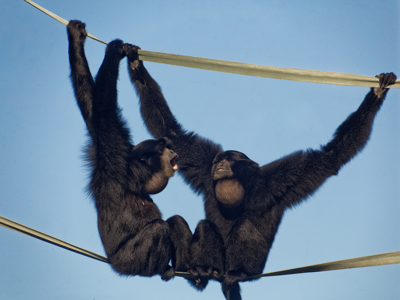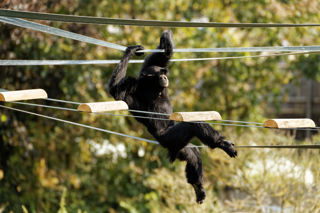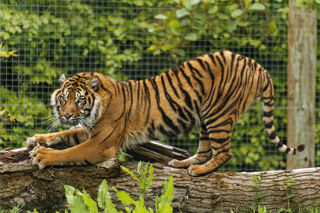
Siamang
Siamangs are apes and like all apes, including chimpanzees and gorillas, they do not have a tail. This is an easy way to tell the difference between monkeys and apes. Siamang are larger than their gibbon relatives. They have long black fur and adults have a throat sac that is used to call over long distances.

Siamangs have long arms that they use to hang from branches and swing through trees. This swinging movement is called brachiation. They live in family groups made up of a monogamous pair (which means a single male and female live together) and their offspring. Each pair has their own territory which they defend from their neighbours through loud call displays.

Breeding occurs throughout the year. The adults share parental care with the male doing most of the carrying of the infant from eight months onwards. Infants remain with their parents until the age of eight years when they will leave the group to start their own. Females normally give birth every two to three years.
The main part of a siamang’s diet is leaves but they will also eat fruit, flowers and small animals.
The main threat facing the siamang is habitat loss due to logging and agriculture. A small proportion of their habitat is protected but not enough to sustain a big population. They are also in danger due to poaching for the pet trade.
Key Facts:
Conservation Status: Endangered
Distribution: Indonesia, Malaysia
Habitat: Tropical Forest
Diet: Animals, Flowers, Fruit, Insects, Leaves
Height: 70 – 90cm
Weight: 10 – 15kg
Gestation: 7 months
No. of young: 1
Life Span: 35 years

SUPPORT OUR ANIMALS
If you're looking for an alternative way to donate to Twycross Zoo, you can help support our animals and our zoo keepers by purchasing something from our Amazon Wishlist!
Updated regularly by our zoo keepers, the items on the list help to provide enrichment for our animals and keep their habitats well maintained.
Every donation helps us as a conservation charity.
